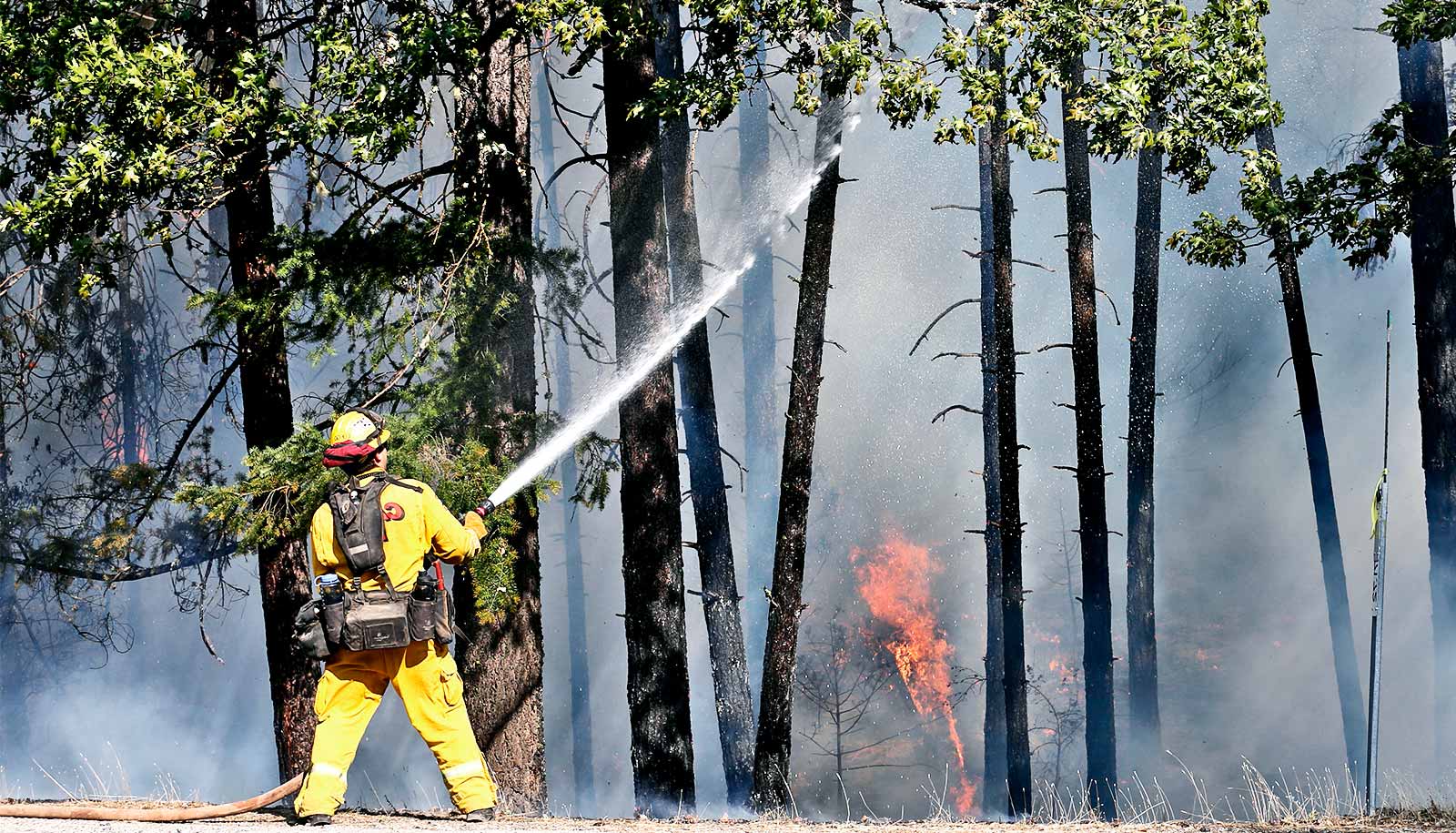
Wildfire smoke fills the air in downtown on June 28, 2023 in Chicago, Illinois. (Credit: Scott Olson/Getty Images )
Wildfire, farming air pollution may be worst for your brain
Wildfires and agriculture and farming emissions may be the top sources of air pollution linked to increased risk of dementia, research finds.
Wildfires and agriculture and farming emissions may pose especially toxic threats to cognitive health, according to a new study.
Increasingly, evidence shows exposure to air pollution emissions makes the brain susceptible to dementia. The findings of the new study, published in JAMA Medicine , point to a strong likelihood that agriculture and wildfires, with their release of a range of harmful emissions at high concentrations, need to be more closely studied and monitored for their risks to public health, specifically dementia.
“We saw in our research that all airborne particles increased the risk of dementia but those generated by agricultural settings and wildfires seemed to be especially toxic for the brain ,” says Sara Adar, associate chair of the department of epidemiology in the School of Public Health at the University of Michigan. She currently leads several large cohort studies on the impacts of exposures on cognitive aging and dementia.
“Our findings indicate that lowering levels of particulate matter air pollution, even in a relatively clean country like the United States, may reduce the number of people developing dementia in late life,” Adar says.
“This work suggests that particulate matter air pollution from agriculture and wildfires might be more neurotoxic compared with other sources. However, more research is needed to confirm these effects, especially for these two sources which have received less attention in prior research,” says Boya Zhang, a research fellow who focuses on the effects of air pollution on cardiopulmonary disease and cognitive aging.
“Given that the development of dementia could take a long time, this study mainly aimed to provide evidence for policymakers to reduce exposures to these sources of emissions.”
The findings come as unusually poor air quality is regularly triggering alerts in the US. The alerts are aimed at protecting the public from the unseen, swirling mix of microscopic toxins in air pollution, specifically fine particulate matter or PM 2.5 . It is one of the most concerning elements of air pollution. At less than 2.5 microns in size, PM 2.5 is less than the width of a human hair. Because it’s so small, it can enter the brain through the nose directly or cross the blood-brain barrier in other ways. PM 2.5 is also known to affect the lungs, heart, and in emerging research, the brain and cognitive function.
“These findings are quite timely given the increasing frequency of wildfire smoke in our communities,” Adar says. “Our data suggest that in addition to some of the more obvious health impacts of wildfire smoke like irritation to our throats and eyes along with breathing difficulties, high smoke days might also be taking a toll on our brains.”
The record number of air quality alerts in the US this year are due in large part to smoke from wildfires burning in Canada since May. The effect of wildfire is not new in the US, especially given the fires in the western part of the country.
Adar, a long-time environmental epidemiologist, says that wildfire smoke is becoming a more widespread stressor with many cities experiencing 30-plus days each year impacted by smoke. Given the extremely high levels of exposure to the public, wildfires are thought to contribute up to 25% of fine particulate matter exposures over a year across the US and as much as 50% in some western regions of the country, Adar says.
“While individual wildfires may be short-lived, these events are becoming more frequent in our communities due to warmer temperatures, drier conditions, and longer fire seasons. As we’ve seen, wildfire smoke can also travel very far distances.”
The new findings are based on research into the development of dementia among nearly 30,000 adults from across the US over an 18-year period. The data comes from the Health and Retirement Study, a nationally-representative collection of cohorts of older adults who have been followed since 1992.
The researchers based pollution estimates in the study on home addresses of participants. Participants have been interviewed biennially about their cognition, overall health, and health behaviors until death or loss of contact for the survey.
They observed that higher levels of particulate matter air pollution, especially from agriculture and wildfires, were associated with greater risks of dementia. The findings could not be explained by other factors such as individual, neighborhood, socioeconomic status, occupation, or hometown or region of the country.
“With the knowledge of which sources are more toxic than others, it may be possible to design interventions for specific sources as a more effective way to decrease the burden of dementia,” Zhang says.
Dementia is currently the seventh leading cause of death and one of the major causes of disability and dependency for older people, according to the World Health Organization.
The research specifically sought to test the hypothesis that a variation in emission sources could explain which are most toxic, but measuring the emissions with their distinct physical and chemical characteristics is challenging. Past studies analyzing exposures to source specific fine particulate matter meant researchers mainly investigated relationships with the total mass of fine particulate matter in the air.
“In our study, we used a sophisticated prediction model that includes information about the chemical transformations and dispersion of pollution from different sources to estimate the levels of source-specific particulate matter air pollution at participants’ residential addresses,” Zhang says. “This approach is beneficial because it not only accounts for pollution directly emitted by a source but also pollution generated through reactions with other chemicals in the air.”
Since the average level of exposure to PM 2.5 for the people studied was less than the National Ambient Air Quality Standard, this is not just an issue of extreme pollution events, the researchers say, though it’s clear that the air quality from wildfire events is worsening.
This research suggests that it’s not just sending people with respiratory ailments to the hospitals but there may also be longer lasting effects to the body. With the changing climate, it’s likely that these threats to health will increase.
The National Institute of Environmental Health Sciences and the National Institute of Aging funded the work.
Source: University of Michigan
The post Wildfire, farming air pollution may be worst for your brain appeared first on Futurity .
Share this article:
This article uses material from the Futurity article, and is licenced under a CC BY-SA 4.0 International License. Images, videos and audio are available under their respective licenses.
Related Articles:
Wildfire health hazards extend hundreds of miles
Aug. 23, 2019 • futurity4 wildfire smoke health problems and how to deal with them
July 9, 2021 • futurityLinks/images:
- https://doi.org/10.1001/jamainternmed.2023.3300
- https://www.futurity.org/air-pollution-brain-performance-workforce-productivity-2658052/
- https://www.futurity.org/farming-greenhouse-gas-emissions-paris-agreement-2509082-2/
- https://www.futurity.org/wildfire-smoke-health-problems-2592902/
- https://www.futurity.org/traffic-air-pollution-alzheimers-2919332/
- https://www.futurity.org/health-risks-wildfire-smoke-2932642/
- https://news.umich.edu/wildfires-and-farming-activities-may-be-top-sources-of-air-pollution-linked-to-increased-risk-cases-of-dementia/
- https://www.futurity.org/wildfire-farming-emissions-dementia-risk-2960922/
- https://www.futurity.org


